


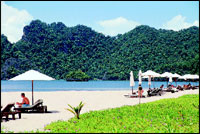 Coconuts, Spice & Everything Nice!
Coconuts, Spice & Everything Nice!
KAREN ANAND on Malaysian cuisine�s curries, noodles and rice dishes at Tanjung Rhu in Langkawi. With photographs by FARZANA CONTRACTOR. |
|
THEY say that Malaysian food can be summed up by the phrase �coconuts and spice and all things nice�. When you land in the ultra modern city of Kuala Lumpur, you don�t have to wait for lunch or dinner to realise this. On the breakfast buffet itself, between the cereals, fruit and cold cuts, are an array of Malaysian curries, noodles and rice dishes � Beef Rendang, a spicy, thick coconut beef curry, Squid Sambal, thick rings of squid in a red, chutney-like masala and Fried Kway Teow, spicy stir-fried flat noodles. The spread looks more like it was destined for the dinner table, but locals lap it up with crisp, flaky parathas known as Roti Canai and mop up the curries with plain boiled rice.
What is amazing as you roam the night markets in search of Gucci or Armani rip offs, is the importance of food, everywhere. Like most of Asia, Malaysians eat all the time; in fancy restaurants, little roadside dhabbas and on the street. Street food could be completely Chinese (they are the only community serving pork in the country). Steamboat is a great street favourite � hundreds of skewers of various meats and vegetables are stacked up, ready for you to dip into boiling hot stock or water. You wonder how the owner can keep track of who�s eating what � but they are clever chaps. Each bamboo skewer is colour coded and notched according to the price. Next door, you�ll find Malays of Indian Muslim origin, tossing up rotis stuffed with mince on a tawa, much like our baida rotis and opposite him you may find a rotund lady, with her head covered in a scarf, cooking satays on charcoal.
In the North, on the idyllic island of Langkawi, a stone�s throw from the Thai border, food is lighter and more fragrant using fresh herbs and spices like Kaffir lime leaf, fresh turmeric, lengkuas (galangal or blue ginger) and a tangy lime, known locally as limau kesturi.
As far as ingredients go, fresh red chillies and Belacan (pronounced blachan), dried shrimp paste are ground into a fresh sauce or Sambal along with fragrant lime juice. This accompaniment is a must for everyday dishes. The lime can be substituted with our limboo. If you find Belacan too �high� it can be substituted with dried prawns available in local markets here, which you soak and then pound into a paste. Other sambals can be less fiery and fierce with the addition of cucumber, pineapple and onion.
Lemon grass is a must for soups and curries. Kaffir lime leaf, which is a fragrant addition to salads and stir fries, is available dry and fresh in Delhi and Pune. Galangal or Lengkuas, a deeply aromatic ginger like rhizome is difficult to substitute. It is available dry in some stores or in easy to carry, water packed jars in Thailand and Malaysia.
|

Home Page
About the mag
Subscribe
Advertise
Contact Us

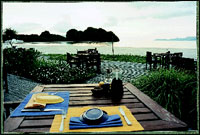 From the breakfast table, you also realise in a shot, no historical nor cultural explanation needed, that Malaysia is clearly a melting point of cultures and therefore cuisines; Thai, Chinese, Indian and what is known as �Malays�, who themselves are a cross between two local tribes and later arrivals from China. The cross-cultural borrowing in the kitchen has led to a number of uniquely �Malaysian� dishes.
From the breakfast table, you also realise in a shot, no historical nor cultural explanation needed, that Malaysia is clearly a melting point of cultures and therefore cuisines; Thai, Chinese, Indian and what is known as �Malays�, who themselves are a cross between two local tribes and later arrivals from China. The cross-cultural borrowing in the kitchen has led to a number of uniquely �Malaysian� dishes.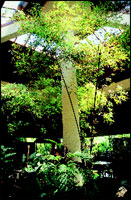 These are basic staples which you will find in any street market in most areas of the country. Then there are the numerous local and regional specialities. The East Coast is littered with beaches and smelly fishing villages known as kampungs. In a small town called Chukai, near Kijal on the East coast, we feasted on the freshest Garoupa, steamed in ginger and spring onion, large white Prawns in Sambal, Lobster and Squid. We also discovered that this little culinary
goldmine, called Tong Juan, was known for miles for their luscious stuffed crabs.
These are basic staples which you will find in any street market in most areas of the country. Then there are the numerous local and regional specialities. The East Coast is littered with beaches and smelly fishing villages known as kampungs. In a small town called Chukai, near Kijal on the East coast, we feasted on the freshest Garoupa, steamed in ginger and spring onion, large white Prawns in Sambal, Lobster and Squid. We also discovered that this little culinary
goldmine, called Tong Juan, was known for miles for their luscious stuffed crabs.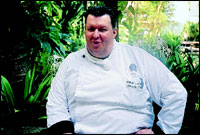 Tanjung Rhu (Cape of Casuarinas) was our destination � a luxury resort which looks and feels more like your private dream escape. This is not a destination for those in search of night life and entertainment. Tanjung Rhu is the place to unwind, relax, enjoy the superb private beach and the wonderful food. Apart from a range of international favourites, fine dining and Mediterranean restaurants, all with individual dedicated chefs, their local specialities, prepared for us by Chef Zamzuri Tajudin were quite extraordinary. Zamzuri, encouraged by Executive Chef Ueli, who seems more at home here than in his native Switzerland, uses fresh quality ingredients, beautifully presented making full use of local handicrafts, textures and colour. He shared several of his recipes with us, which he prepared in the lush greenery of their outdoor all day dining restaurant, Sands.
Tanjung Rhu (Cape of Casuarinas) was our destination � a luxury resort which looks and feels more like your private dream escape. This is not a destination for those in search of night life and entertainment. Tanjung Rhu is the place to unwind, relax, enjoy the superb private beach and the wonderful food. Apart from a range of international favourites, fine dining and Mediterranean restaurants, all with individual dedicated chefs, their local specialities, prepared for us by Chef Zamzuri Tajudin were quite extraordinary. Zamzuri, encouraged by Executive Chef Ueli, who seems more at home here than in his native Switzerland, uses fresh quality ingredients, beautifully presented making full use of local handicrafts, textures and colour. He shared several of his recipes with us, which he prepared in the lush greenery of their outdoor all day dining restaurant, Sands.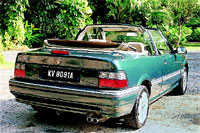 In order to cook Malaysian food successfully at home, you will need a few basic things. To make Rempah or spice paste, which is essential to their Gulais (curries), cooks still use a large mortar and pestle to fine grind. A cleaver, rather than a knife, is used for chopping and we found, even in hotels, that traditional cooks preferred using the side of a tree trunk for a chopping board rather than a sanitised plastic one. Coconut curries are still slow-cooked in clay pots and vegetables and noodles are stir-fried in a wok with a sloping side.
In order to cook Malaysian food successfully at home, you will need a few basic things. To make Rempah or spice paste, which is essential to their Gulais (curries), cooks still use a large mortar and pestle to fine grind. A cleaver, rather than a knife, is used for chopping and we found, even in hotels, that traditional cooks preferred using the side of a tree trunk for a chopping board rather than a sanitised plastic one. Coconut curries are still slow-cooked in clay pots and vegetables and noodles are stir-fried in a wok with a sloping side.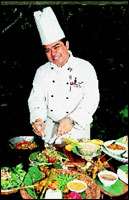 Malaysian peanuts are famous, large, slightly oily and very tasty, they are the base of the famous peanut sauce which accompanies most satays. Another use is a wonderful spicy dry snack where peanuts are tossed with chopped onions, salt, sugar and deep fried anchovies (Ikan Bilis) rather like a bhel.
Malaysian peanuts are famous, large, slightly oily and very tasty, they are the base of the famous peanut sauce which accompanies most satays. Another use is a wonderful spicy dry snack where peanuts are tossed with chopped onions, salt, sugar and deep fried anchovies (Ikan Bilis) rather like a bhel.